Exploring the Psychological Effects of Urinary Incontinence and Bedwetting in Children
Abstract
The study is developed to examine the psychological and emotional impact of urinary incontinence and bedwetting in children and young people aged 5-18 years old. The current available evidence mentions that psychological impact of urinary incontinence among children and young people includes lower self-esteem, depressive symptoms, bully, humiliation in the society and others. In addition, it leads to poor development of relationship between peers at schools among the children as the individuals are mocked and bulled for their condition related to urinary incontinence or bewetting (Butler,2001). An understanding of the psychological and emotional impact of urinary incontinence has been consistently hampered by inter-changeability of terminology, varied inclusion criteria, diverse methodologies and equivocal findings (Butler,1998). For those going through these challenges, seeking psychology dissertation help can be beneficial as it provides valuable support in exploring all these complex issues further.
The purpose of this systematic review will be to examine and evaluate the psychological and emotional impact of urinary incontinent in children. A Clear aim and objective will be defined. A research question will be formulated according to the Population, Exposure, Comparison (optionall) and Outcome (PECO). Systematic literature searching of primary studies will be carried out on variety of academic electronic databases and grey literature will be carried out. All the included studies will becritically appraised and will received a quality assessment rating of ‘strong, moderate and weak’. A data extra extraction form will be designed andused for all the studies that will meet the inclusioncriteria.A narrative synthesis of the finding will be conducted. Conclusion and recommendation will be made for practice and future research.
Introduction:
The purpose of this systematic review will be to ascertain the psychological and emotional impact of urinary incontinent in children and young people. The systematic review will be focusing on answering a research question that has clinical appurtenant in paediatric urology. The review will be driven by process of integrating the best evidentiary information available by conducting comprehensive and thorough search of literature examining psychological and emotional impact of urinary incontinent in children and applying specific inclusion and exclusion criteria. The critical appraisal of the papers will be carried out allowing the breakdown of information in parts to evaluate their significance, weakness and filter out the low-quality papers. The data synthesis of the finding and narrative analysis will be carried out. On the basis of the results a conclusion and its implication in practice will be discussed and suggestion will be made for future practice and further research.

Background Literature
Urinary incontinence in paediatrics is a complex condition determined by sporadic urinary incontinence day and night times (Alexopouloset al.2006). The International Children’s Continence Society (ICCS,2014) definition of bedwetting or nocturnal enuresis is intermittent incontinence e.g. leaking of urine in discrete amount occurring during nights in a child, aged 5 years or older at least once a week for three months (Austin et al, 2014). The ICCS (2014) definition of daytime of urinary incontinence is leaking of urine in discrete amounts while awake in children in child of 5 years or older twice a week for three months (Joinson et al,2016). Children urinary incontinence is defined either as primary nocturnal enuresis for children who never been consistently dry (Bascom et al.2018) or secondary enuresis for children who have been dry for more than six months but started wet after (Butler and Heron, 2005).
The symptoms of urinary incontinence include daytime urgency, frequency, leaking, incontinence, nocturnal, hesitancy, weak stream, intermittent stream, holding manoeuvres, dysuria, post micturition dribbling (Austin et al, 2014). Bedwetting affects approximately 15 to 20% of children aged 5 years old, 5% of 10-year-old children and 2 to 3% of teenagers (Caldwell et al,2013). Wright (2015) reported that the prevalence of daytime urinary incontinence ranging between 4.7% and 11.7% at age of 7 years of age and 0.8% and 12.5% at 11-12 years of age, with overall prevalence rate of 6.4%. The aetiology of why children wet the bed remains mostly unclear and some studies have suggested factors such as bladder capacity, inadequate levels of Anti-Diuretic Hormone (ADH) and elevated arousal threshold (Capdevilaet al.2012).
In the study by Von Gontard et al. (2017), it is mentioned that children who bed wet during the day show greater amount of low self-esteem compared to the children and young people who have bedwetting problem at night. This is because in the daytime the children are found to be active and explore as well as interact more with friends and peers. It provides opportunity to the peers and friends to tease the children and make them feel humiliated and bewildered as a result of the condition. In comparison, the study by Grzeda et al. (2017) mention that children who have bedwetting habit during the night is less exposed to social victimisation. This leads them to show reduced amount of distress and anxiety regarding the health condition. The study by von Gontard et al. (2019) inform that bedwetting leads young people to feel guilty as well as embarrassed with the health issue. This is because they feel lack of self-control over the health condition in turn making them show withdrawal from the society and interact with others. The children and young people suffering from bedwetting issues are found to show hindered social interaction at school out of distress regarding their health condition (Marciano et al. 2016). There is also the risk of some children being physically punished for urinary incontinence by their parents/guardians (NICE,2010).
Rational for this systematic review:
Urinary incontinence in children and young people are pervasive issues and studies have shown that prevalence rate for night wetting to be approximately 9-18% and 16.9% for day time wetting (Von Gontard et al,2015). Rate of psychological and emotional effects increases in children to 20=30% for night time wetting and 30-50% for day time wetting (Butler et al,2005). Children and young people with urinary incontinences often have symptoms of more than one emotional and psychological types (Young et al, 2006)). Despite their prevalence and effects, urinary incontinence problems are poorly researched when it comes to psychological and emotional impact. It has emerged as an important public health issue in the last few decades and has become the focus of considerable clinical, policy and practice research as evidence supporting the detrimental impact urinary incontinence in children and young people psychological and emotional well-being.
Urinary incontinence has profound emotional, social and psychology impact on children and young people due to the associated embarrassment, shame, and feeling of guilt, social isolation and it can be very humiliating for many children when it happens (Sullivan et al, 2015). Children and young people with urinary incontinences have increased chances of developing more serious symptoms such as depression and suicidal ideas if not support appropriately due to bullying, humiliation and social isolation ICCS,2014). Urinary incontinent can seriously undermine children and young people self-esteem and quality of life (Redsell et al,2003). Evidence has increasingly shown that children and young people with urinary incontinent are at risk of problem continuing into beyond adolescent age; (Yeung et al, 2006) found that greater proportion of frequents urinary incontinent were children aged 5-19 years, daytime wetting and lower urinary tract symptoms such as increased voiding frequency and urgency were more common for adolescents and argue that this provide evidence that urinary incontinent is less likely to resolve with increasing age . Therefore, better understanding of psychological and emotional impact of urinary incontinent predicting their persistence is needed to improve the identification of children and young people who should be prioritise for early recognition and treatment. The research question in this systematic review has particular relevant and importance for the author, who works as paediatric urology clinical nurse specialist and see many children and young people who are completely debilitated bytheir urinary incontinent on daily bases. Number studies have been done evaluation the psychological and emotional impact of urinary incontinent, however, these dated have never been collated in a systematic review. With this systematic review, author hopes to address some of the major psychological and emotional impact of urinary incontinent in children and young people.
Key Research Question
The key focus for this systematic review will be to examine evidence exploring and examining a research question. The specific research question to guide this systematic review will be as follow:
What is the psychological and emotional impact of urinary incontinence in children and young people aged 5-18 years old?
Aim
The aim of the study is to determine the impact of urinary incontinence on the psychology and emotion of the children and young people who are between 5 to 18 years.
Objective
The primary objective of this systematic review is to determine psychological and emotional impact of urinary incontinence in children. Therefore, in order to meet the aim of the study and answerto research question following objective will be covered.
To identify the factors affecting psychological and emotional health of children and young people suffering from urinary incontinence
To evaluate the impact of urinary incontinence on psychology and emotions of children and young people
To analyze the challenges experienced due to psychological and emotional effect of urinary incontinence on children and young people
To recommend strategies for overcoming the challenges experienced due to psychological and emotional effect of urinary incontinence on children and young people
Ethical Consideration
There is no research ethical board approval needed for this systematic review because will not be examination or evaluating patient’s level data collection. However, this systematic review will need systematic review board to approval in order to ensure that it is complies with reported guidance of systematic review.
Review Design
The methods for this thesis is based on systematic review. Systematic review is thorough and comprehensive study and rigorously interpretation of literature that relates to answer particular research questions (Aveyard,2019). The key component of systematic review is presence of specific definition features indicating high level of meticulous research methods which ensure that the systematic review is reproducible, transparent, using strategies that reduce biases and random errors and show how their conclusion is generated (Greenhalgh,2019). Systematic review is not simply reviewing of literature but enables researchers to make an objective assessment of primary research evidence and, in particular, of the outcomes of specific interventions/exposure or treatments and are often used as starting points for developing clinical guidelines (Parahoo,2014). They are the result of a rigorous process and are considered the gold standard of literature-based research (Aveyard et al, 2016).
First step for this systematic review will be to formulate research question using Population, Exposure, Comparison (optionall) and Outcome (PECO), followed by goals and objectives for the review (Polit and Beck,2017). PEO was useful model to structure an answerable question as it breaks down the question into four key elements of population, exposure, comparison and outcomes (Chapman et al.2009). The research question that will be formulated for this systematic review had great significant and importance for the author who work as paediatric continent CNS and on daily based see many children and young people with urinary incontinence and how this has impacts their psychological and emotional wellbeing and how lovely and isolated these are children.
This systematic review will focus on the primary studies regarding the psychological and emotional impact of bedwetting in children and young people aged 5-18 years old.
A robust and thorough electronic databases search will be performed to identify appropriate primary studies and grey literature that answer the research question (Polit and Beck, 2017). Primary studies that used quantitative, qualitative and mix methods will be reviewed and included if they met the inclusion criteria. Search will not be limited to any particular country therefore international studies were included.
The eligibility criteria for the papers that will be selected will be based on population, exposure, outcomes PEO model.
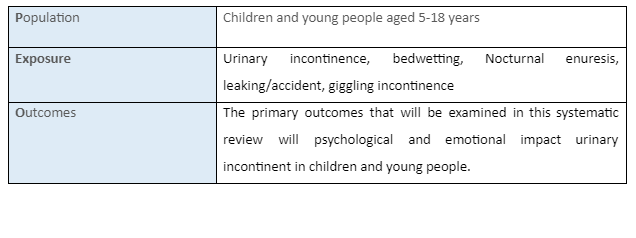
Inclusion and Exclusion Criteria:
The inclusion and exclusion criteria in systematic review is important to be identified as it assist to ensure the raised research question is focussed during the search and any bias can be prevented during selection of studies as per the criteria previously informed in the study (Ansell et al. 2017). The inclusion criteria in the study are referred to the characteristics which are required to be considered as compulsory while executing the research. However, the exclusion criteria are referred to the factors which are regarded disqualified prospects for the study and avoided to be included in the research (Ayaz‐Shah et al. 2018). The inclusion criteria of the study will be journals which are published from 2014-2020, written in English, fully accessible, involves information of psychological and emotional impact of urinary incontinence on children and adults and academic in nature. The exclusion criteria will involve journals published before 2014, written in other language expect English, not fully accessible, includes information of psychological and emotional impact of urinary incontinence on adults and non-academic articles.
The articles that are published on and after 2014 will be selected and others will be excluded so that most updated information is used in forming the study. The use of updated information in research helps to ensure greater validity and reliability of the study as backdated data which are able to create biased and hindered conclusion are avoided to be used in the study (Grzeda et al. 2017). The articles written in English will only be included and others will be excluded as the researchers only have knowledge regarding English language due to which the researcher would be unable to determine and understand the contents other than English. The articles which are not fully accessible will not be used in the study as detailed information as required by the researcher to explore the research question and objectives regarding the topic cannot be gathered. The articles which focus on urinary continence in adults will be avoided as they would lead to gather information that are not valid for the study as the research is focussing on gathering information regarding children and young people. The non-academic articles will be excluded so that scientifically approved information is presented in the study ensuring enriched execution of the research.
Search Strategy
The aim of this systematic review search will be to blueprint search strategies that will pull in as much pertinent studies as possibleto identify primary studies that the answer the research question, yet abide within the time-frame (Aveyard, 2019). A thorough and integrative literature search strategy will be performed on the following electronic databases; EBSCO host, Medscape, CINAHL, PubMed, Embase, PMC, Scopus. Initially wide scaping and preparatory search will be carried out on Google/Google Scholar for studies on psychological and emotional impact of urinary incontinent in children using set of habitual search expression. The Boolean Operators search idioms will used (“AND,” “OR”, “NOT”) in order to connect search words together by broadening and narrowing search to single out studies (Chapman et al.2009). Subject heading and the terms including of combinations of MeSH and free text will used see (see table 1 below).
Table 1. Search terms
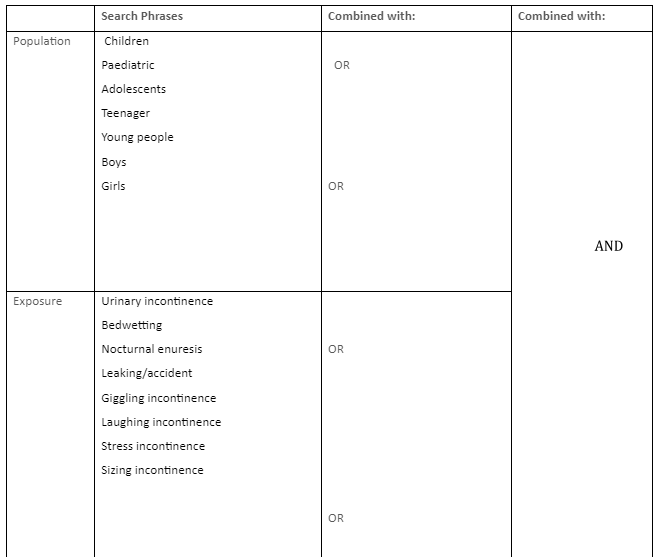

Data selection:
A data extraction table will be designed using principles of the PRISMA statement for reporting systematic review and the Cochrane Collaboration’s tool for assessing risk of bias (Moher et al, 2010; Higgins et al, 2011). In an initial screening, titles and abstracts of all duplicated citations will be were screened for relevance and excluded if inclusion criteria were not met (Gerrish and LACEY, 2010). Thereafter, abstracts will be reviewed to group studies into either (1) psychological impact, (2) emotional impact of urinary incontinent and (3) day time and night urinary incontinent (4) excluded. Papers determined as potentially relevant to the this systematic review will be examined for eligibility and unless clearly described one or more inclusion criteria, the full text of the paper was then examined to determine if it still met the inclusion criteria for this systematic review and answer to the research question (Khan,2008). If some papers meet inclusion criteria, paper will be reviewed in full and see the date for psychological and emotional impact of urinary incontinence could be extracted from the papers to be included (Smith,2009). A record will be made of all the papers examined, the reasons for exclusion of the studies will be recorded in the Search flowchart which will illustrate the search, screening and selected study for the final review (see Figure B). So far potential preliminary studies identified for fully text examination (see the list Appendix).
Critical Appraisal tool:
The papers that have been identified through the search to specifically answer the research question in this systematic will be critically appraise at this stage in order to assess their strengths and weak (Fathergill and Lipp,2014). First step at this point will be to read and re-read the papers meticulously in order to critically appraise them for their methodology and quality of their evidence and overall outcomes to answer the research question (Williams, 2011). In order to do that critical appraisal tool will be used and for the purposes of this systematic review The Joanna Briggs Institute (JBI) Critical Appraisal tools for use in Systematic Reviews(2016) will be used for cross-section study and quasi-experimental study andCASP 2013 Critical Appraisal tool will be used for cohort studies as it is more comprehensive with cohort tool. The critical appraisal tool guide in order to critique the primary studies selected for this review, ensuring a well-founded and objective method to critical appraisal process, allowing one to filter out poor quality papers and differentiate misleading studies (Walsh andWingens, 2009) (see Appendix F).Key characteristics of each papers such as methods studies, studies type, methods of data collection, key finding, strengthen and weakness of the studies will be extracted so that outcomes of each papers can be captured (Greenhalgh,2019. The quality appraisal of studies will be carried by assessing and interpreting outcome by systematically considering its validity, finding and relevance to the research question in this systematic review (Wright, et al,2007).
Once the critical appraisal of paper selected is completed. A data extraction form will be designed and employed to systematically extract data from all the papers included in this review. The data extracted will include all the details specific to the review question and will fulfil the requirement for narrative synthesise of outcomes such as study details, (authors, years, country of publication, funding, and affiliations), participants (characteristics, setting, inclusion and exclusion criteria and attrition), exposure and comparison details, during and outcomes measure(See appendix G data extra form).
Result/data analysis:
An appropriate method of reporting the psychological and emotional impact will be determined based on the type of data extracted from included studies. It is anticipated that the mean differences in psychological and emotional will be reported. These results will be tabulated to enable quantitative and heterogeneity assessment for potential pooling of results using systematic review. Quantitative methods rely on strong numerical data to measure variables using statistic system in order to quantify and analysis the relationship among the studied variables so that objective statistical discussion to support or rebut alternative knowledge can be asserted (Sukamolson,2007).

Discussion:
The discussion section will present a summary of the efficacy and external validity of the studies reviewed. This section will be given a clear rundown of the main results of the studies and endeavours to put the outcomes in a wider paediatric context with psychological and emotional impact of urinary incontinent in children and young people. The discussion section will be comprehensively referenced with up-to-date and contemporary literatures sources answer the point raised in the research question which will show that author contemplated the findings in alliance with existing studies and gaps in knowledge(Greenhalgh, 2019).
Narrative synthesis:
Since this systematic review will be containing range of heterogeneous data exploring the psychological and emotional impact of urinary incontinent, author has decided that a narrative synthesis will constitutes the best instrument to synthesise the findings of this systematic review (Evans,2002). This is the process that will bring together the result of the studies reviewed in order to draw conclusion based on the body of evidence of the data analysis and sources of literature (Mays et al, 2001). Narrative synthesisapproach will give the systematic review and synthesis of findings from all the included papers that relies primarily on the use of words and text to summarise and explain the findings of the synthesis (Reissman,2008).
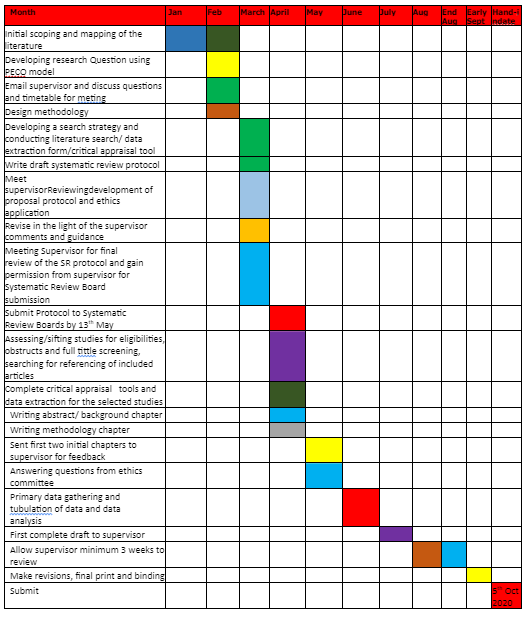
References:
- Ansell, D., Crispo, J.A., Simard, B. and Bjerre, L.M., (2017). Interventions to reduce wait times for primary care appointments: a systematic review. BMC health services research, 17(1), p.295.
- Aveyard, H (2019) Doing a literature review in health and social care: Practical guide. 4th Edition. Open University Press. McGraw-Hill Education.
- Aveyard, H., Payne, S. and Preston, N. (2016) A post-graduate’s guide to doing a literature review in health and social care. Maidenhead, UK: Open University Press. McGraw-Hill Education.
- Ayaz‐Shah, A.A., Hussain, S. and Knight, S.R., (2018). Do clinical trials reflect reality? A systematic review of inclusion/exclusion criteria in trials of renal transplant immunosuppression. Transplant International, 31(4), pp.353-360.
- Berry AK (2006) Helping children with nocturnal enuresis: the wait-and-see approach may not be in anyone’s best interest. American Journal of
- Beryy, A.K. (2006) Helping children with nocturnal enuresis: the wait and see approach may not be in anyone’s best interest. American Journal of Nursing
- Bettany-Saltikov, J. (2012) How to do a systematic review: literature review in nursing. Maidenhead: Open University Press.
- Boland, A., Cherry, M.G. and Dickson, R. (2014) Doing a systematic review: a student’s guide. London: SAGE.
- Bruce, N., Pope, D. and Stanistreet (2019) Quantitative methods for health and research: A practical interactive guide to epidemiology and statistic. Second Edition. John Wiley and Sons Ltd.
- Butler, R. and Holland, P. (2000) The three systems: a conceptual way of understanding nocturnal enuresis. Scandinavian Journal Urology Nephrology.34: 270–77.
- Butler, R. and Heron J. (2008) An exploration of children’s views of bed-wetting at 9 years. Child Care Health Dev. 34(1):65–70
- Butler, R.J. and Heron, J. (2008) The prevalence of infrequent bedwetting and nocturnal enuresis in childhood. A large British cohort. Scandinavian Journal Urology Nephrology. 42:257–264
- Cormack, D., Gerrish, K. and Lathlea, J. (2015) The research process in nursing. 7th Edition. Wiley-Blackwell.
- Critical Appraisal Skills Programme (CASP) (2013) www.casp-uk.net (last accessed 29 November 2019)
- Curtis, E. and Drennan, J. (2013) Quantitative health research: issues and methods. 1st Edition. Open University Press
- Fawkes, Carol, Ward, Elena, Carnes, Dawn (2015) what evidence is good evidence? A Masterclass in critical appraisal.International Journal of Osteopathic Medicine. 18 (2): 116-129
- Forsythe WI, Redmond A (1974) Enuresis and spontaneous cure rate. Study of 1129 enuretics. Archives of Disease in Childhood; 49: 4, 259-263.
- Fothergill, A. and Lipp, A. (2014). A guide to critiquing a research paper on clinical supervision: enhancing skills for practice. Journal of Psychiatric & Mental Health Nursing, 21(9), 834-840.
- Gerrish, K. and Lacey, A. (2010). The research process in nursing. 6th Edition. Sussex: Blackwell Publishing.
- Greenhalgh, T. (1997) How to read a paper: Assessing the methodological quality of published papers. British Medical Journal. 315:pp305–308.
- Greenhalgh, T. (2019) How to read a paper: Basics of evidence-based medicine and healthcare. 6th edition. Wiley Blackwell
- Grzeda, M.T., Heron, J., von Gontard, A. and Joinson, C., (2017). Effects of urinary incontinence on psychosocial outcomes in adolescence. European child & adolescent psychiatry, 26(6), pp.649-658.
- Higgins, J. & Thomas, J. (2019). Cochrane Handbook for Systematic Reviews of Interventions
- Higgins, J.P.T., Green, S. (2011) Cochrane Handbook for Systematic Reviews of Interventions. Version 5.1.0 ed. The Cochrane Collaboration.
- Israel, F., Austin, P., Von Gontards, S.B.A. and Homsy, Y. (2018) Paediatric Incontinence: Evaluation and clinical management. Wiley Blackwell
- Jain, S. and Bhatt, G.C. (2015) Advances in the management of primary monosymptomatic nocturnal enuresis in children. Paediatric International Child Health.
- Khan, J. (2008). Research methodology. New Delhi: APH Publishing.
- Khan, K.S., Kunz, R. and Kleijnen, J. (2003) Systematic reviews to support evidence-based medicine: how to review and apply findings of healthcare research. London: Royal Society of Medicine Press.
- Lee, P. (2006b) Understanding and critiquing quantitative research papers. Nursing Times. 102: 28, 28–30
- Marciano, R.C., Cardoso, M.G.D.F., Vasconcelos, M.M.D.A., Paula, J.J.D., Oliveira, E.A. and Lima, E.M., (2016). Mental disorders in children and adolescents with lower urinary tract dysfunction. Brazilian Journal of Nephrology, 38(4), pp.441-449.
- Moher, D., Liberati , A., Tetzlaff, J., Altman, D.G (2010) . Preferred reporting items for systematic reviews and meta-analyses: the PRISMA statement. International Journal Surgery. 8(5):336-341
- Paediatric Continence Forum (2014) Paediatric Continence Commissioning Guide. Bit.ly/PCF Continence Commissioning
- Parahoo, K. (2006) Nursing Research: Principles, Process and Issues. London, UK: Palgrave MacMillan
- Petticrew, M. and Robert, H (2008). Systematic reviews in the social sciences. A practical guide. Oxford: Blackwell publishing.
- Polit D. and Beck C. (2017) Nursing Research: Generating and Assessing Evidence for Nursing Practice (10th Ed.) Philadelphia, USA: Wolters Kluwer Publishing.
- Rodgers et al (2009) Testing methodological guidance on the conduct of narrative synthesis in systematic reviews, Evaluation, 15(1), pp.49-74
- Rogers, J. (2002) Managing daytime and night-time enuresis in children; Nursing Standard 16 (32) 45-54
- Sullivan, S. (2015) Factors predicting atypical development of night-time bladder control. Journal of Developmental and Behavioural Paediatric 36 (9): 724-733
- Von Gontard, A., De Jong, T.P., Badawi, J.K., O'Connell, K.A., Hanna-Mitchell, A.T., Nieuwhof-Leppink, A. and Cardozo, L., (2017). Psychological and physical environmental factors in the development of incontinence in adults and children. Journal of Wound, Ostomy and Continence Nursing, 44(2), pp.181-187.
- von Gontard, A., Overs, C., Moritz, A.M., Thomé‐Granz, S. and Hussong, J., (2019). Incontinence and headache in preschool children. Neurourology and urodynamics, 38(8), pp.2280-2287.
- Walsh, M. and Wingens, L. (2009) Introduction to research. Nelson Thornes: Cheltenham
- Williams, C. (2011). Research methods. Journal of Business & Economics Research. 5(3):pp62-71
- Wright, A. (2008) Evidence-based assessment and management of childhood enuresis. Paediatrics and Child Health.18(12):pp561-567
- Wright, R.W., Brand, R.A., Dunn, W. and Spindler, K.P. (2007) How to Write a Systematic Review. Clinical Orthopaedics and Related Research, 455, pp. 23–29;
Appendix E: Critical
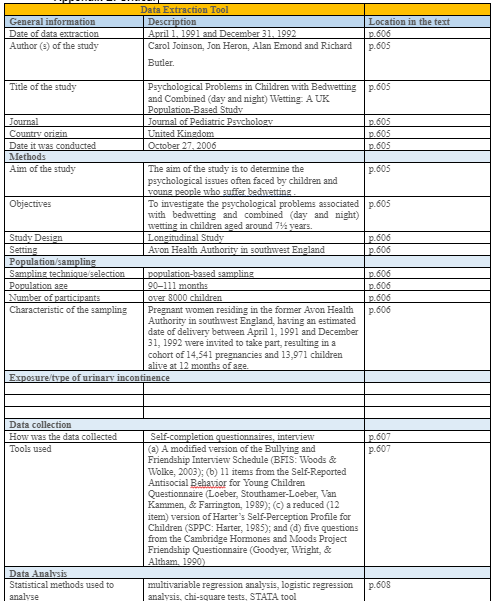
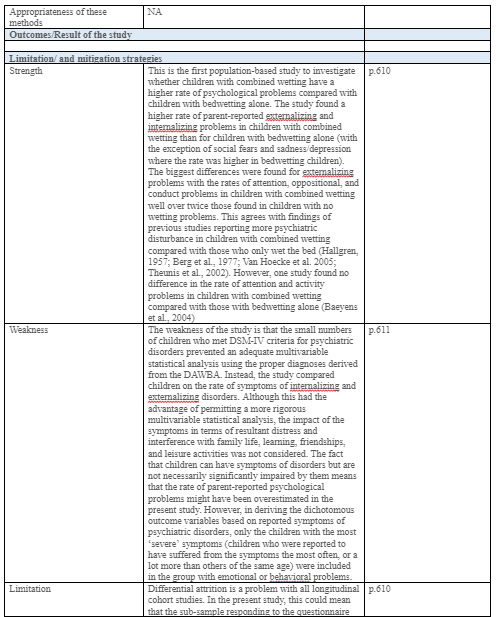
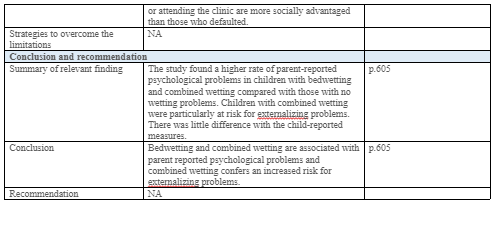
Appendix E: Critical Appraisal tools:
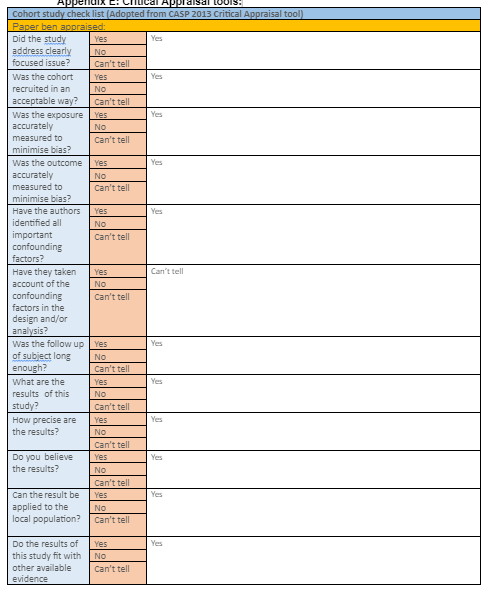
Looking for further insights on Exploring the Potential Therapeutic Efficacy of Diclofenac on Lymphoblast Cells? Click here.
- 24/7 Customer Support
- 100% Customer Satisfaction
- No Privacy Violation
- Quick Services
- Subject Experts



